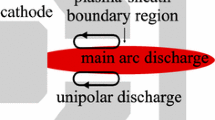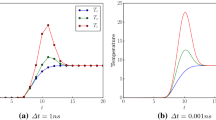Abstract
We consider the numerical solution of a Tonks–Langmuir integro-differential equation with an Emmert kernel, which describes the behavior of the potential both in the main plasma volume and in the thin boundary (Langmuir) layer. In the volume plasma the potential varies insignificantly, while in the thin layer near the wall (the sheath) it experiences rapid variation. To correctly resolve the behavior of the sheath solution, the numerical region is partitioned into several intervals with a uniform discrete grid in each interval. The interval lengths and the grid increments are successively halved. The second derivative is approximated at the halving points using a nonsymmetrical stencil, which ensures second-order approximation. Near the boundary of the numerical region a step-doubling condensation grid is used, which also ensures second-order approximation of the second-derivative operator. The condensation grid and the numerical algorithm are constructed. Some numerical results are reported.
Similar content being viewed by others
REFERENCES
L. Tonks and I. Langmuir, “A general theory of the plasma of an arc,” Phys. Rev., 34, No. 6, 876–922 (1929).
E. R. Harrison and W. B. Thompson, “The low pressure plane-symmetric discharge,” Proc. Phys. Soc. London, 74, Part 2, No. 476, 145–152 (1959).
G. A. Emmert, R. M. Wieland, A. T. Mense, and J. N. Davidson, “Electric sheath and presheath in a collisionless, finite ion temperature plasma,” Phys. Fluids, 23, No. 4, 803–812 (1980).
R. C. Bissel and P. C. Johnson, “The solution of the plasma equations in a plane parallel geometry with a Maxwellian source,” Phys. Fluids, 30, No. 3, 779–786 (1987).
R. C. Bissell, P. C. Johnson, and P. C. Stangeby, “A review of models for collisionless one-dimensional plasma flow to a boundary,” Phys. Fluids B, B1, No. 5, 1133–1140 (1989).
K. Sato, F. Miyawaki, and W. Fukui, “Sheath and presheath in a collisionless open-field plasma,” Phys. Fluids B, B1, No. 4, 725–733 (1989).
D. S. Filippychev, “Second-order approximation of the radial part of the Laplace operator on condensing grids,” Prikl. Mat. Informatika, MAKS Press, Moscow, No. 11, 75–99 (2002).
D. S. Filippychev, “Using condensing grids to simulate an electron-beam relativistic amplifier in a cylindrical waveguide with a plasma-dielectric filling,” Prikladnaya Matematika i Informatika, MAKS Press, Moscow, No. 12, 50–70 (2002).
E. T. Whittaker and G. N. Watson, A Course of Modern Analysis, Cambridge Univ. Press (1927).
A. A. Samarskii, Theory of Difference Schemes [in Russian], Nauka, Moscow (1977).
N. N. Vorob'ev, Fibonacci Numbers [in Russian], Nauka, Moscow (1978).
A. A. Samarskii and E. S. Nikolaev, Methods of Solving Grid Equations [in Russian], Nauka, Moscow (1978).
Rights and permissions
About this article
Cite this article
Filippychev, D.S. Simulation of the Plasma-Sheath Equation on Condensing Grids. Computational Mathematics and Modeling 15, 123–137 (2004). https://doi.org/10.1023/B:COMI.0000023524.82122.49
Issue Date:
DOI: https://doi.org/10.1023/B:COMI.0000023524.82122.49




